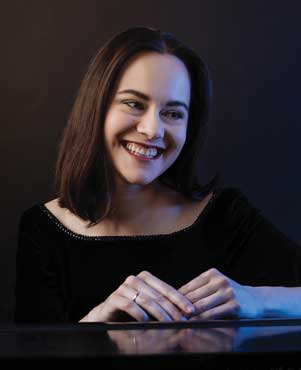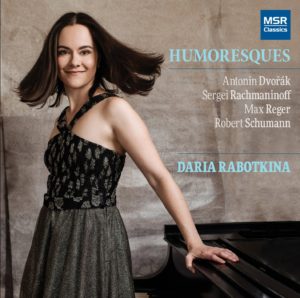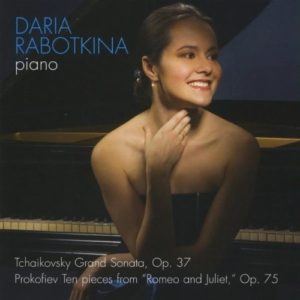
About
Daria Rabotkina, born in Kazan, Russia, studied at the Kazan State Conservatory and later with Vladimir Feltsman at Mannes College. Winner of top prices at international competitions, including from the Concert Artists Guild, she has performed under renowned conductors including Michael Tilson Thomas, and in distinguished venues in Europe, Japan, and the US, including at Carnegie Hall. Her CDs have garnered universal praise. Rabotkina holds a doctorate from Eastman School of Music and is on the faculty of Texas State University.
Program
- No. 2 in A-flat Major (Andantino)
- No. 3 in F Minor (Allegro moderato)
- No. 5 in F Minor (Allegro vivace)
- No. 6 in A-flat Major (Allegretto)
- Maestoso—Allegro con brio ed appassionato
- Arietta: Adagio molto semplice e cantabile
- No. 3, The Fountain of the Acqua Paola
- No. 4, Clouds
- Allegro
- Adagio
- Allegro assai
Program Notes
Schubert and his publishers were quite aware of the growing market of amateur piano players in the years after the Congress of Vienna, and he was happy to write for it. These enthusiastic amateurs represented a source of ready income to a composer who was never fully free from financial concerns. Yet Schubert would not have felt that he was “writing down” to such performers. Throughout his life he wrote a vast number of dances and short pieces for piano, composed purely for the pleasure of the performer (and of any listener who might be present).
In the fall of 1827, only a year before his death, Schubert set out to write specifically for this market. In these months he completed eight impromptus and a set of six short pieces published in July 1828 with the title Momens [sic] musicals (in faulty French probably supplied by the publisher). These musical moments were brief pieces of varying difficulty, probably intended for performance at home (the original title has since been corrected to Moments musicaux). Schubert would have welcomed performances of individual pieces from the set, and this recital offers four of the six.
Moment musical No. 2 in A-flat Major, a gentle rondo, alternates a tranquil and dotted chordal opening section with passages in F-sharp minor that proceed above flowing left-hand triplets, both themes set in 9/8 meter. No. 3 in F Minor is the best-known of the set and also the earliest to be written—Schubert composed it in 1823. It was originally published under the title Air russe, though there does not seem to be anything particularly Russian about it. The graceful main theme, of a Rosamunde-like charm, has struck some listeners as ballet music; Schubert builds the piece on repeated phrases, then rounds it off with a long coda. No. 5 in F Minor is the most difficult of the set, with its quick pace (Schubert marks it Allegro vivace), chordal writing, and powerful dactylic (long–short–short) rhythms. The concluding No. 6 in A-flat Major was written somewhat earlier, in December 1824, and originally published under another fanciful title supplied by the publishers: Les plaintes d’un troubadour. Longest of the movements, this one is unusually expressive, full of brief episodes in different moods and keys.
The years 1813–21 were exceptionally trying for Beethoven. Not only was he having financial difficulties, but this was also the period of his bitter legal struggle for custody of his nephew Karl. Under these stresses, and with the added burden of ill health, Beethoven virtually ceased composing. Where the previous two decades had seen a great outpouring of music, in these years his creative powers flickered and were nearly extinguished; in 1817, for example, he composed almost nothing. To be sure, there was an occasional major work—the Hammerklavier Sonata occupied him throughout all of 1818—but it was not until 1820 that he put his troubles, both personal and creative, behind him and was able to marshal new energy as a composer.
When this energy returned, Beethoven took on several massive new projects, beginning work on the Missa solemnis and making early sketches for the Ninth Symphony. And by the end of May 1820 he had committed himself to writing three piano sonatas for the Berlin publisher Adolf Martin Schlesinger. Although Beethoven claimed that he wrote these three sonatas—his final piano sonatas—“in one breath,” their composition was actually spread out over a longer period than he expected when he agreed to write them. He finished the Sonata in E Major, Opus 109, immediately, but ill health postponed the other two. Notes in the manuscript indicate that Beethoven completed Opus 110 in December 1821 and Opus 111 in January 1822, but he was still revising them the next spring prior to their publication.
Beethoven’s final sonata is in only two movements: a powerful opening movement in two parts and a concluding movement in theme-and-variation form. Ernest Hutcheson notes that Beethoven’s performance markings for these three sections offer not just indications of speed but also the clearest possible suggestions about interpretation. The markings translate: “Majestic,” “with liveliness and passion,” and “very simple and singing.”
The brief opening section—only 16 bars long—is largely static and serves to gather energy and prepare for the Allegro con brio ed appassionato, which leaps suddenly out of a quiet murmur of 32nd notes. The Allegro’s opening three-note figure sounds as if it must be the beginning of a fugue theme, but while there are fugal elements in its development, Beethoven never treats the theme as a strict fugue. This movement, built upon the continual recurrence of the opening three-note figure, seethes with an almost brutal and slashing energy.
A complete contrast, the final movement is all serenity. Beethoven marks it Arietta (“little aria”); and the lyric theme that will serve as the basis for variation is of the utmost simplicity and directness. The theme is followed by five variations, and these variations are not so much decorations of the theme as they are an organic development of it. Each variation seems slightly faster than the one before it (though the underlying tempo of the movement remains unchanged), and the final variation—long, shimmering, and serene—serves as an extended coda to the entire movement. This final variation employs trills that go on for pages. Can it be that Beethoven, who had been deaf for years when he wrote these works, made such heavy use of trills so that he could at least feel the music beneath his hands even if he could not hear it?
When Beethoven’s copyist sent this sonata to the publishers, they wrote back to ask if there was a movement missing—they could not believe that Beethoven would end a sonata like this. But this is exactly the form Beethoven wanted, and his final piano sonata ends not in triumph but in a mood of exalted peace.
Like Mozart, American composer Charles Griffes died a few months short of his 36th birthday. His death deprived American music of a major talent and probably deprived music of a number of major works. A prodigy as a boy, Griffes had intended to make his career as a virtuoso pianist, and at age 19 he went to Berlin to study piano at the Stern Conservatory. But the lure of composition proved too strong, and in Berlin Griffes studied privately with Humperdinck before returning to the United States in 1907. He became director of music at the Hackley School, a private school for boys in Tarrytown, New York, and remained there for the rest of his brief life. Griffes’s music evolved quickly: at first influenced by Brahms and Strauss, he quickly fell under the spell of the exotic new sounds that composers were producing in the early years of the 20th century. The first of these influences was the impressionism of Debussy and Ravel, but Griffes was soon drawn to the sensuality of Scriabin and to the music of the Far East, a fascination that would also captivate Szymanowski and many other composers in these years.
Under these influences, Griffes composed a set of four piano pieces in 1915–16 that he published as his Roman Sketches, Opus 7. Each of the pieces was prefaced by a quotation from the collection Sospiri de Roma by the Scottish novelist and poet William Sharp (1855–1905), one of Griffes’s favorite writers. Sharp was a complex personality: attracted to mysticism and to the pre-Raphaelite movement, he published much of his work under the pen name Fiona Macleod. On this recital Ms. Rabotkina offers the two final movements of Roman Sketches, “The Fountain of the Acqua Paola” and “Clouds.”
As its title suggests, “The Fountain of the Acqua Paola” is a water piece. As a student in Berlin, Griffes had been much impressed by a performance of Ravel’s great water piece Jeux d’eau, and—given the Roman setting of Sharp’s poems—we might also note that at just the moment Griffes was composing this music, Ottorino Respighi was composing his Fontane di Roma, another great water piece. Griffes prefaces his score with five lines from Sharp’s poem:
Shimmering lights,
As though the Aurora’s
Wild polar fires
Flashed in thy happy bubbles,
Died in thy foam.
Marked Allegro moderato, Griffes’s fountain piece sparkles and shimmers before us like water in bright sunlight. Part of the charm of this music is its rhythmic complexity: Griffes sets different rhythms against each other and changes meters frequently. The music rises to a great climax but subsides on a quiet discord.
If “The Fountain of the Acqua Paola” recalled Ravel, “Clouds” inevitably recalls Debussy’s “Nuages” from Nocturnes. But where Debussy kept his tonal palette subdued and gray, Griffes gives us the motion of great clouds moving across a bright sky. He quotes seven lines from Sharp in the score:
Mountainous glories,
They move superbly;
Crumbling so slowly,
That none perceives when
The golden domes
Are sunk in the valleys
Of fathomless snows.
Griffes marks his piece Tranquillo and sets it in the unusual meter 7/4. The most striking feature of the music is its bitonality—the pianist’s hands are often in different keys, and at some points Griffes expands the many strands of this music across four staves. The colors seem to cry out for full orchestra, and in fact Griffes made an orchestral version of the piece, which was premiered by Stokowski and the Philadelphia Orchestra in 1919.
The son of radio commentator Paul Harvey (whose full name was Paul Harvey Aurandt), Paul Aurandt has had a distinguished career of his own—and in many different fields. Aurandt studied at the Chicago Musical College of Roosevelt University, where he earned his Master’s degree in piano performance. At the same time, the young man assisted his father on Harvey’s radio program, The Rest of the Story; it was Aurandt who created and wrote the program. Aurandt is a playwright (his first play, Burton, about the life of actor Richard Burton, was produced in Florida in 1996) as well as a composer and pianist. His most recent major composition—Jehanne: An Anthem, an opera about Joan of Arc—was premiered in Arizona in 2018.
Aurandt’s Piano Sonata in B-flat Minor is the work of a young man: he copyrighted the sonata in 1975, when he was 27. The sonata has apparently never been published (though the composer did prepare an authorized printing in 2000), but it has been championed by several distinguished pianists and has been recorded at least three times, once by the composer himself. The idiom of this sonata might best be described as neo-Romantic: anyone coming to this music without knowing its composer might well guess that it is a work of Rachmaninoff’s, given its rich harmonies, advanced technical demands, and thematic elements that recur in subsequent movements. This is a sonata in the grand manner, full of sweep, bold gestures, and a full-throated sonority, a sonata that demands a virtuoso performer at every moment.
It is in the three-movement form of the classical piano sonata, taking the traditional fast–slow–fast sequence. The opening Allegro establishes the sonata’s dramatic character from its first instant. This opening gesture will furnish much of the material for this movement, though there are more reflective and lyric secondary themes. The Adagio brings a complete change, at least at first. Gone are conflict and fire of the first movement, and in their place we enter a different world with a quiet chordal melody. This peace is short-lived, however, as the music quickly erupts into glistening runs and soon spills over with energy. The concluding Allegro assai returns to the manner of the first movement. It bursts to life on a theme driven sharply along syncopated rhythms, and at moments this movement feels like a perpetual motion. But this rush of energy is interrupted along the way by gentler interludes, and at the end the sonata drives to its conclusion on a great torrent of sound.
Listen
[spacer height=”20px”]
Buy Music
Steinway Society The Bay Area is a participant in the Amazon Services LLC Associates Program, an affiliate advertising program designed to provide a means for sites to earn advertising fees by advertising and linking to Amazon.com


